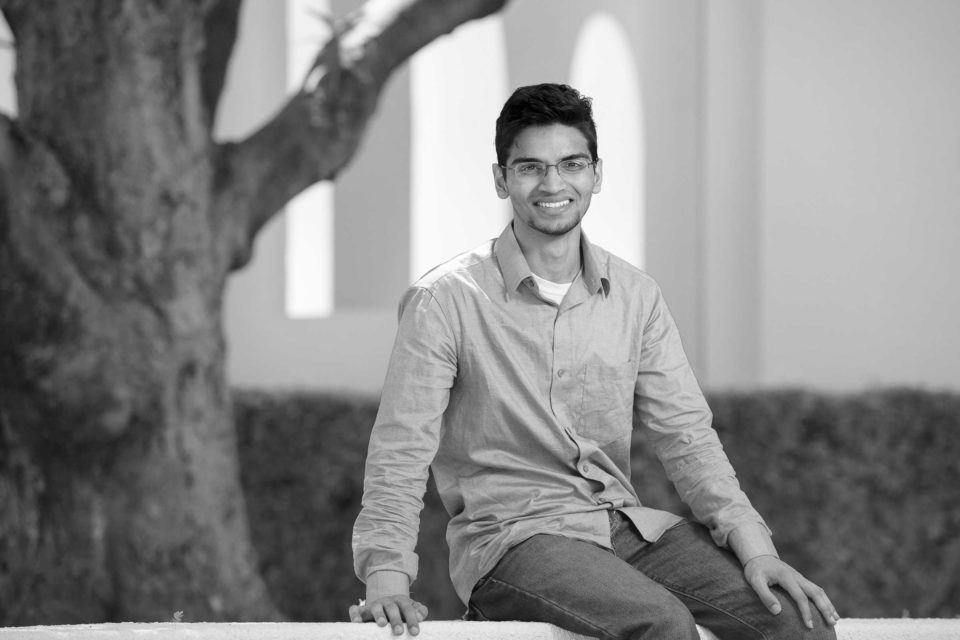Stanford student volunteers in projects near and far
During his four years at Stanford, Zeshan Hussain explored several paths in public service, including direct service, activism and philanthropy.
As a Stanford student, Zeshan Hussain found many ways to take part in public service projects near and far – on campus, at a high school on the other side of San Francisco Bay and at a tropical disease hospital in India.
In January 2016, along with other members of the Muslim Student Union (MSU) and other student groups, Hussain helped organize Syrian Refugee Awareness Week, which included a teach-in about the crisis, a benefit dinner to raise funds for the charity United Muslim Relief and a clothing collection drive in student residence halls.
The organization brought in Sana Khatib, a Syrian-American activist whose father is a former political prisoner and whose family fled Syria and the Assad regime when she was young. Through a clothing drive the MSU also collected 500 pounds of clothing just on campus from students and faculty, an accomplishment Hussain described as “very heartening.”
“We wanted to raise awareness about the crisis and its history, and about the personal struggles of students who may be refugees, or students who have families that are refugees,” he said.
Throughout his senior year, Hussain traveled to Averroes High School in Fremont, California, to teach health modules under the auspices of the Muslim Health Collaborative at Stanford.
Hussain helped start the group, which is primarily composed of medical students. The students first met at Jumu’ah, a congregational prayer held on Fridays in the sanctuary room of the Center for Inter-Religious Community, Learning, and Experiences (CIRCLE) on the third floor of Old Union.
“We designed the curriculum as well as the presentations,” he said. “So far I’ve taught modules on nutrition, drugs and alcohol and mental health. It can be very, very tough to get and keep the attention of high school students, but they ask great questions and, for the most part, are really curious about the topics. It’s been really fun.”
Earlier this year, Hussain volunteered at the Sir Ronald Ross Institute and Hospital of Tropical and Communicable Diseases in Hyderabad, India, where he spent his early years. (Hussain and his family immigrated to Ohio when he was in grammar school.)
At the hospital, Hussain put his computer science expertise to work – he is earning a coterminal master’s degree in computer science – by creating a prototype of a machine learning system programmed to predict the outbreak of malaria, under a grant from the Indian Institute of Chemical Technology, a national research center.
“I would love to go back and continue working on the system,” said Hussain, who also shadowed two residents on their patient rounds during his three-week stay at the hospital.
Hussain began his public service journey at Stanford as a sophomore, when he was selected as a “service scholar” in Branner Hall, the university’s public service theme dorm.
Throughout the year, Branner’s service scholars – sophomores, juniors and seniors – engage in public service projects as individuals and in groups.
We wanted to raise awareness about the crisis and its history, and about the personal struggles of students who may be refugees, or students who have families that are refugees.
Zeshan Hussain
During the 2015-16 academic year, Branner residents made and served lunch to low-income and homeless people in nearby Menlo Park and made and sold loaves of braided bread for Challah for Hunger at Stanford. They also took a field trip to San Francisco, where they visited the Golden Gate National Parks Conservancy, the Delancey Street Foundation, a residential program that provides vocational training to former substance abusers and ex-convicts, and Castro Street, one of the foremost symbols of LGBT activism in the world.
Each year, Branner residents meet in their lounge for “community conversations” on a variety of topics, including ethical and effective service, faith and service, and self-care and service. During a conversation on “identity and service,” Kathy Martinez, associate director of the Diversity and First-Gen Office at Stanford, conducted a “Beyond the Line” exercise revolving around race, sexual and gender identity.
The exercise is designed to help people explore the intent and impact of their actions, thoughts and beliefs. Martinez read statements aloud, then asked students to step on the “I agree” or “I disagree” side of an imaginary line. Then, they discussed their choices.
Hussain said one of the statements the students discussed was: “Using ‘him’ or ‘her’ without knowing someone’s gender identity is rude.”
“This was a very powerful community conversation, because it forced the students to talk about and reflect on issues that are usually brushed under the rug,” he said.
As a senior, Hussain served as one of Branner’s four “theme associates,” students who take leadership roles in the dorm.
Hussain said one of the key insights he learned over the last three years of public service was how important it was to understand the individual communities he was trying to serve, and how important it was not to impose his beliefs or methods on them.
“At the end of the day, it’s not really about what you’re doing, but how it’s affecting the community you’re serving,” he said. “My service to people and communities is really learning from them how I can contribute – in any way I can – to help them live better lives.”

